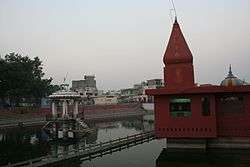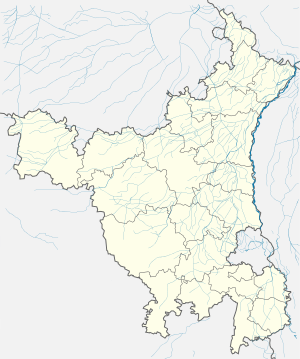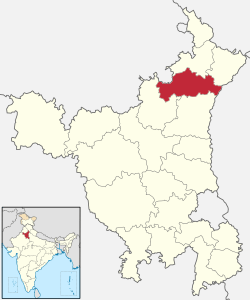Pehowa
| Pehowa Prithudak | |
|---|---|
| Town | |
 Sarasvati River and temple, Pehowa | |
 Pehowa Location in Haryana, India  Pehowa Pehowa (India) | |
| Coordinates: 29°59′N 76°35′E / 29.98°N 76.58°ECoordinates: 29°59′N 76°35′E / 29.98°N 76.58°E | |
| Country |
|
| State | Haryana |
| District | Kurukshetra |
| Government | |
| • Type | democratic |
| Elevation | 224 m (735 ft) |
| Population (2011)[1] | |
| • Total | 38,853 |
| Time zone | UTC+5:30 (IST) |
| ISO 3166 code | IN-HR |
| Vehicle registration | HR 41 |
| Website |
haryana |
Pehowa is a town and a municipal committee in Kurukshetra district in the Indian state of Haryana. The Hindu genealogy registers at Peohwa, Haryana are kept here at the Pruthudak Tirath on the banks of Sarasvati river.
History
Two inscriptions dated ninth Century A.D. found at Pehowa mention that the place was controlled by Mahendrapala, of Kanauj and a Vishnu temple was constructed at this place by Tomara family, but such historic temple is not found in present day Pehowa.[2]
The earliest extant historical reference to the Tomara dynasty occurs in the Pehowa inscription issued during the reign of the Pratihara king Mahendrapala I (r. c. 885-910 CE) [Tomars of Delhi were vassals of Partiharas of Kannauj].[3] This undated inscription states that Jaula of the Tomara family became prosperous by serving an unnamed king. His descendants included Vajrata, Jajjuka, and Gogga. The inscription suggests that Gogga was a vassal of Mahendrapala I. It records the construction of three Vishnu temples by Gogga and his step-brothers Purna-raja and Deva-raja. The temples were located at Prithudaka (IAST: Pṛthūdaka; Pehowa), on the banks of the river Sarasvati.[4] No information is available about the immediate successors of Gogga.[5] The Pehowa inscription suggests that this particular Tomara family was settled around the Karnal area. However, F. Kielhorn suggested that this Tomara family actually resided in Delhi: they may have visited Pehowa on pilgrimage, and built a temple there.[6]
Geography
Pehowa is located at 29°59′N 76°35′E / 29.98°N 76.58°E.[7] It has an average elevation of 224 metres (734 feet). The Telsil Pehowa was created on 1 November 1979 and is at a distance of 27 km from Kurukshetra.[8]
Demographics
As of 2001 India census,[9] Pehowa had a population of 83,547. Males constitute 52% of the population and females 48%. Pehowa has an average literacy rate of 89%, higher than the national average of 59.5%: male literacy is 85%, and female literacy is 76%. In Pehowa, 13% of the population is under 6 years of age. Punjabi dialects are spoken in the countryside, while Hindi is the official language.
Religious significance
Pehowa is considered religious place of high importance and to highlight the sanctity of the place, Haryana State Government has banned sale, possession, consumption and purchase of non-vegetarian food in the town limits.[10] Slaughtering of animals is also banned in the town through the court orders.[10] The town is considered sacred to Ahirs, Hindus and Sikhs.[11]
Places of significance

Prithudak Teerth
Pehowa is a very ancient town, believed to pre-date the Mahabharat War by many centuries as it flourished on the banks of now dried up Saraswati River in those days. By the time of the Mahabharata war, the river had long dried up, yet was still a very holy place where people offered "Pinda Pradhan" to their ancestors. It is still called as "Pitrudhak Teerth" and was the holiest place for these oblations to be done much before Prayag or Gaya as the local legend goes. Lord Krishna is believed to have taken the Pandavas to this place before the war started and made them take the blessings of Sarasawati Mata and of their ancestors. Presently, the river does not have any inflows nor outflows and is stagnant. The Pillars on the entrance to the Saraswati Temple date many centuries. Saraswati Sarovar is located in this town, where people perform pooja and religious rituals.[11]
Prithudak is one of the important point in the 48 kos parikrama of Kurukshetra.
Genealogy registers
Hindu genealogy registers at Pehowa are the genealogy registers of pilgrims maintained here by pandas.[12][13][14]
Sarasvati Temple
Pehowa is known to be an important place and pilgrimage on the banks of mythical and revered Sarasvati River. There is an ancient temple dedicated to Goddess/River Saraswati.[8] This is another temple of this city forming a part of 48 kos parikrama of Kurukshetra.
Kartikeya Temple
Kartikeya Temple, Pehowa is a 5th century temple.[8]
Other Temples
- Pashupathinath Mahadev Temple[8]
- Prachi Tirtha [15] (Part of 48 kos Parikrama)
- Brahmayoni tirtha (Part of 48 kos Parikrama)[15]
- Arunai Temple, Arunay (Part of 48 kos Parikrama)[15]
- Shri Dakshinmukhi Hanuman Temple[8]
 Saraswati Temple main entrance - ancient archway.
Saraswati Temple main entrance - ancient archway. Fresco on the Sarasawti temple wall - Archaeological treasure
Fresco on the Sarasawti temple wall - Archaeological treasure Eroded Fresco on the Sarasawti temple wall - Archaeological treasure.
Eroded Fresco on the Sarasawti temple wall - Archaeological treasure. Kartikeya Temple
Kartikeya Temple
References
- ↑ "Census of India Search details". censusindia.gov.in. Retrieved 10 May 2015.
- ↑ Sharma, S.K. (2005). Haryana : Past & Present. New Delhi, India: Mittal Publications. p. 128. ISBN 9788183240468. Retrieved 25 October 2014.
- ↑ Sailendra Nath Sen 1999, p. 339.
- ↑ Dilip Kumar Ganguly 1984, pp. 116-117.
- ↑ D. C. Ganguly 1981, p. 705.
- ↑ Dilip Kumar Ganguly 1984, p. 117.
- ↑ Falling Rain Genomics, Inc - Pehowa
- 1 2 3 4 5 "Sub-Division Pehowa". National Information Centre NIC. NIC Govt owned. Retrieved 24 October 2014.
- ↑ "Census of India 2001: Data from the 2001 Census, including cities, villages and towns (Provisional)". Census Commission of India. Archived from the original on 2004-06-16. Retrieved 2008-11-01.
- 1 2 "Haryana bans meat in holy towns of Kurukshetra, Pehowa". The Indian Express. 25 August 2012. Retrieved 24 October 2014.
- 1 2 Yadava, S.D.S. (2006). Followers of Krishna : Yadavas of India. New Delhi: Lancers Publishers & Distributors. p. 2. ISBN 9788170622161. Retrieved 25 October 2014.
- ↑ Tracing your Asian roots www.overseasindian.in.
- ↑ Hindu Pilgrimage Marriage Records www.movinghere.org.uk.
- ↑ 10 Places Across The World That Help You Trace Your Ancestors, India Times, 29 Jan 2016.
- 1 2 3 http://kurukshetra.nic.in/bulkdata/pdf/tirthalist.pdf
| Wikimedia Commons has media related to Pehowa. |
